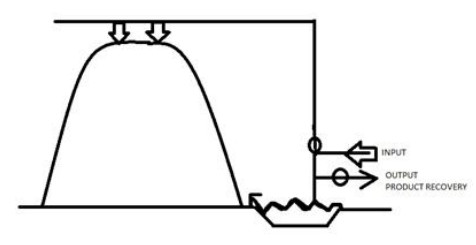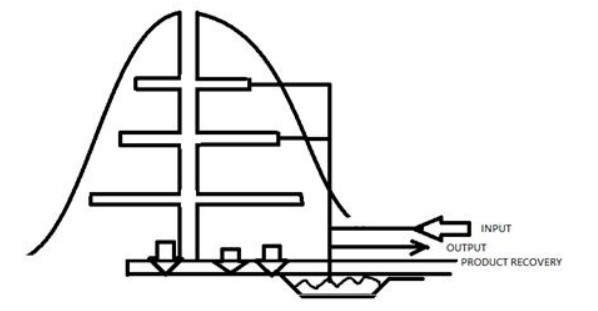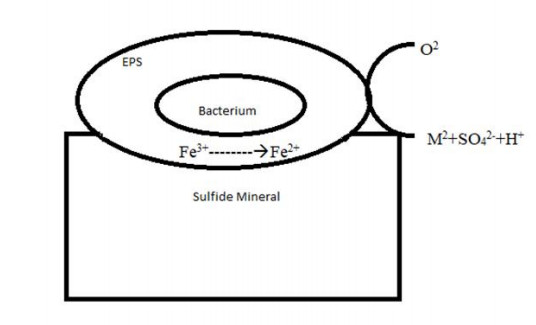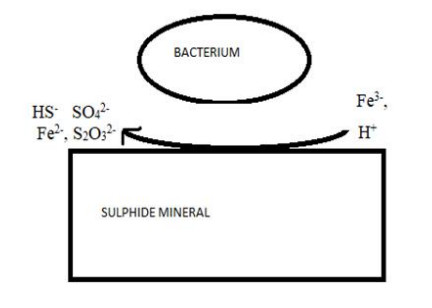1.
Introduction
Bioleaching is a process that is a combination of mining and biohydrometallurgy, a procedure that uses the natural processes of interactions among microorganisms and minerals (Figure 1). These microorganisms, such as bacteria or algae, help in the extraction of metals that are of high value from a lower grade metal ore, industrial wastewater, mining water. Etcetera [1]. There is a huge quantity of low-grade ores, which are the by-products of the separation procedure of ores that are high-grade, and are generally discarded in heaps of waste [2]. Metals from such ores cannot be economically processed with chemical methods. There are huge quantities of such ores, which are of a lower grade, especially ores of copper, which can be processed and extracted profitably by bio-leaching [3].
Critical metals mainly include the platinum group of metals, the rare earth elements (which are commonly abbreviated PGMs and REE), and some other metals, such as cobalt, lithium, cobalt, uranium, and nickel. The platinum group of metals has elements, namely platinum (Pt), iridium (Ir), palladium (Pd), rhodium (Rh), osmium (Os), gold (Au), and ruthenium (Ru) [4]. Among the platinum group of metals, platinum, palladium, and gold are the ones that have major economic importance, followed by rhodium, ruthenium, and iridium. Critical metals, which mainly include the platinum group of metals, and the rare earth elements, have gained importance because they are essential for economic development, but a matter of concern is their availability, as they are scarce, and so a constant supply is at risk. This scarcity and ambiguousness about the availability of supply of critical metals result in a mercurial price variation of these metals [5]. These elements are essential in electronic and green energy technologies, but are only available in low abundance or are produced in only a few countries [6].
Microalga are microscopic organisms that are photosynthetic in nature. They can be found in both aquatic and freshwater environments. They have a photosynthetic mechanism that is similar to that of terrestrial plants. Studies show that the biomass of microalgae forms the world's largest group of primary producers, which are responsible for global photosynthesis that can be calculated at 32% [7]. Globally, researchers have emphasized the advantages of microalga, and a few of their benefits are: rapid metal uptake capability, energy and time saving, eco-friendly, user-friendly, ease of handling, overall year occurrence, high efficiency, recyclable/ reusable, economically feasible, and their growth rate is faster when compared to plants with a larger surface to volume ratio [8]. Microalga have the ability to bind up to 10% of their biomass with high selectivity that has an enhancement in their performance, there is no toxic waste generation, they have high applicability to waters containing high metal concentrations, or relatively low contaminant levels [9]. In a study, it has been seen that microalga can remove metals even at low contaminant levels, and, hence, they can be potentially used for the extraction of critical metals from wastewater, industrial, and mining effluents.
2.
Critical metals and their sources
Critical metals are metals that play important roles in various industrial applications [10]. These are identified by supply, demands, imports, and other market factors.
Some of the important critical metals are rare earth metals, platinum group metals, and metals with high economic importance (i.e., copper, cobalt, nickel, and lithium). Some of the common valuable critical metals are gold, silver, zinc, iron, and uranium (Table 1).
Rare earth elements (REE), including lanthanides, yttrium, and scandium, are mostly produced from the industrial wastes and end of life consumer products, as they are used in modern communication equipment [11]. As the concentration of the metals in the waste is low, bioleaching becomes an economical way to extract the metals. REE can also be extracted from fluorescent lamp waste and petrochemical wastes [12].
Gold is generally found alone, but can also be present with mercury or silver. Ores, such as calaverite, sylvanite, and nagyagite are the sources of gold. Gold ores are found in open pits or underground mines.
The main sources of silver are copper ores, copper-nickel ores, lead, and lead-zinc ores. The mineral form of silver is argentite, which is silver sulfide, and can be easily used for bioleaching.
Uranium is naturally present in soil and water. As uranium is a radioactive substance, it can be extracted for reuse from radioactive wastes, like nuclear waste.
3.
Types of bioleaching
There are different types of bioleaching used for different type of ores and metals. Since bioleaching is a very slow process, it is done commercially by controlling the levels of O2, CO2 concentrations, pH, and humidity. The three most commonly used biomining or bioleaching techniques are: ⅰ) slope bioleaching, ⅱ) heap leaching, and ⅲ) in situ bioleaching.
3.1. Slope bioleaching
In this method, the ores are first converted into fine pieces (their powdered form). This powder is then stacked into large piles by the slopes of a mountain, forming a big leaching dump. Over the huge dumps, water is continuously sprinkled. The water contains the microorganisms required for the bioleaching mechanism to occur. At the bottom of the mountain, the sprinkled water gets accumulated, containing the metals from where the metal can be extracted. After separation of the metals, and regeneration of the bacteria in an oxidation pond (Figure 2) has occurred, the water is used again.
3.2. Heap bioleaching
This method is the same as slope leaching, where the only difference is that the ores are arranged in the form of heaps. The heaps are showered with water containing microorganisms, which oxidize the ores and produce the metals. The washed off water from the heaps contains the metals, and the metal recovery is done by treating the leach liquid produced from the ores (Figure 3).
3.3. In situ bioleaching
In the in situ bioleaching method, the ores undergo natural bioleaching. The water solution containing the oxidizing microorganisms are pumped into the ores through pipe systems or drilled passages. The leached-out liquid is collected at the bottom of the ore, and is used for metal extraction.
Copper leaching is an example of heap leaching, as well as the in situ leaching method. Copper ores, from where copper can be extracted, are chalcocite, chalcopyrite, and covellite. Since copper leaching follows the indirect bioleaching mechanism, dilute sulphuric acid is percolated down through the pile, and the liquid coming out of the pile that get stored at the bottom of the pile is rich in minerals. This liquid is collected, precipitated, and purified to extract the metal (Figure 4).
4.
Mechanism of bioleaching
The interaction of microorganisms with the metals undergoing oxidation are proposed in two different leaching mechanisms: "Direct leaching" and "Indirect leaching".
4.1. Direct leaching
Direct leaching is used for metals that can undergo easy oxidation. This is done through a direct catalytic strike on the metals by using microorganisms to separate metals from their ores. Hence, we can say that, in this process, the microorganisms stay in direct contact with the metals.
The microorganisms, namely sulfur oxidizing bacteria that form bacterial biofilms, attach themselves to the minerals through their membranes using enzymatic interactions, leading to breakdowns of the minerals by oxidizing the sulfur moieties [26]. The biofilm is formed by the absorption of the bacterial cells on the mineral surface in a short amount of time [27]. The cells produce extracellular polysaccharide at the contact zone as a response to stress in the surrounding environment, acting as a protective barrier by promoting metabolism, maintaining pH, and taking part in the oxidation process of sulfide [28]. Most iron sulfide ores are oxidized though direct leaching, and the general equation that denotes the chemical reaction is given by:
From the image, we can also see that, along with the formation of SO4, free hydrogen atoms are produced, and Fe3+ converts to Fe2+ and vice versa, where O2 acts as an electron acceptor (Figure 5).
4.2. Indirect leaching
This is the second mechanism of bioleaching which also involves oxidation of the minerals by bacteria. The only difference with the first mechanism is that there is no physical contact of the bacteria and the minerals in this mechanism [29]. The bacteria produce strong oxidizing agents, such as acid, which catalyzes the breakdown of the mineral ores. The bacteria concentrate the oxidizing attacking agents at the inter-surface of the minerals, enhancing the breakdown process. Indirect bioleaching majorly depends on the acid solubility of the minerals [30].
Copper leaching and uranium leaching are indirect leaching. Both the copper and uranium are found with pyrite. The pyrite needs an electron acceptor for acidic breakdwon; hence it is seen that the pyrite is at first broken, then the attack is made on the copper or uranium. The indirect oxidation mechanism occurs through the given chemical reaction:
This produced sulfuric acid will further help in the oxidation of the mineral and separation of the metal of interest [31](Figure 6).
4.3. Use of microalgae in bioleaching
A new approach to the bioleaching mechanism is the use of microalga. It has several advantages over the general bioleaching mechanisms, like high efficiency, with the ability to bind to 10% of their biomass with high selectivity, and producing no toxic materials. Microalgal biofilms tend to extract metals from wastewater that is rich in metallic ions. Microalga take up metals by biosorption and bioaccumulation [32]. In biosorption, the metals are taken up by the cells. Bioaccumulation is the active mode of metal uptake in which microbial activity is involved [33].
4.4. Tolerance of microalgae towards different heavy toxic metals
"Heavy metals" are the metals and metalloids that have densities more than 5 g/cm3, like arsenic (As), cadmium (Cd), chromium (Cr), copper (Cu), iron (Fe), lead (Pb), mercury (Hg), silver (Ag), zinc (Zn), and others. They play a wide range of roles in different industries and products, such as fossil fuel combustion, mining, electroplating, dye and pigments manufacturing, and fertilizers, that produce large amounts of waste material that are discharged into the environment, daily, via wastewater or other pathways [34]. Direct contact, inhalation, and ingestion of these heavy metals poses serious threats to humans (both physical and mental health), causing mutations and genetic damage, impairing the central nervous system, as well as increasing the risk of cancers [35,36]. Hence, it is necessary to remediate these toxic heavy metals before discharging wastewater into the environment. These heavy metal problems have drawn much attention from researchers, and has beoame a significant research field due to their severe deteriorating effects on the environment and human health [37,38].
Concentrations of toxic heavy metals up to a certain level can stimulate the growth and metabolism of microalgae [39]. Microalga have developed multiple strategies of unique self-protection against toxicity of heavy metals, such as heavy metal immobilization, gene regulation, exclusion, and chelation, as well as antioxidants or reducing enzymes that reduce heavy metals via redox reactions [40]. Microalga remove heavy metals by a two-stage mechanism. The first step is the fast extracellular passive adsorption (biosorption), and the second stage is the slow, intracellular, positive diffusion and accumulation (bioaccumulation). Along with cellular polymeric substances, such as peptides and exopolysaccharides with uronic groups, the cell wall of microalga is mainly composed of polysaccharides (cellulose and alginate), lipids, and organic proteins (providing many functional groups (such as amino, carboxyl, hydroxyl, imidazole, phosphate, sulfonate, thiol, and others)), creating great potential to bind heavy metals [41].
Adsorption of heavy metals on the algal surface is a rapid process and occurs via different paths, like formation of covalent bonds between the ionized cell wall with heavy metals, ionic exchange of heavy metal ions with the cell wall cation, and binding of heavy metal cations with negatively charged uronic acids of microalgae exopolysaccharides. The process of heavy metal accumulation inside the cell is much slower. Microalga synthesize antioxidant enzymes, such as ascorbate peroxidase, catalase, glutathione reductase, peroxidase, and superoxide dismutase (SOD), as well as non-enzymatic antioxidants, such as carotenoids, cysteine, ascorbic acid (ASC), glutathione (GSH), and proline to react with free radicals released by heavy metals during adsorption and neutralize them. GSH and ASC are endogenous antioxidants synthesized by microalga, with a key role in the reduction of reactive oxygen species (ROS) and free radicals [42]. Along with maintaining the equilibrium of ROS production and elimination, ASC also protects microalgal cells by regulating metal-containing enzyme activity and the ascorbic acid-glutathione (ASC-GSH) pathway, as well as sustaining the dissipation of surplus excitation energy.
Recent research on Terahertz frequency THz radiation generation, detection, and spectroscopic and imaging tools, such as terahertz time-domain spectroscopy (THz-TDS) [43], (which has the potential to operate in the time and spatial domain to process data obtained from a transmitted or reflected THz beam), opens new avenues for water contamination detection [44]. The key assumption is that liquids have distinct physical properties, and leave a distinct spectral impression when exposed to THz frequencies.
The THz-TDS with metamaterial sensors was applied to detect viable and live microorganisms, such as yeast cells, molds, and bacteria in both ambient and aqueous environments [45]. The sensors are antibody specific to bacteria. which helps to detect the deposition of microorganisms.
5.
Advantages of using bioleaching in the extraction of critical metals
Bioleaching uses principles based on the three basic concepts and utilizes a variety of microbes to mobilize and leach metals from solid materials. The principles are: (1) the excretion of complexing agents, (2) the oxidation and reduction processes, and (3) the transformation of organic or inorganic acids (protons) [46,47]. For all the examined metals from general resources, bioleaching consistently produced the highest metal leaching efficiency (63%–93%) [48]. It has been suggested that the bioaccumulation that occurs when biomass is present may result in the larger yield obtained by bioleaching, as opposed to chemical leaching [49]. In comparison to conventional methods, bioleaching is typically easier to use, it is cheaper to run (as the bacteria involved develop organically), and there is little landscape damage where the mine and surrounding region may be mostly kept intact. The bacteria are readily cultured and renewed, since they thrive in the mine's environment, and require less upkeep. When compared to conventional extraction techniques, this approach is more efficient in every way.
6.
Role of microalga in the extraction of critical metals from various sources
In mining research, the use of microbes to extract minerals from ores is becoming increasingly significant. Since time immemorial, many bacteria have been involved in the dissolution and deposition of chemicals in the earth's crust [50]. Microorganisms are widely used in mining, and have certain distinct benefits over traditional methods. Mineral extraction, using microorganisms, is usually more ecologically beneficial and eco-friendly. The mining of critical metals is as widespread as that of other minerals around the globe, and it likewise necessitates the use of energy-intensive processes, potent chemicals, and harmful by-products [51]. In order to extract the metals, it is necessary to break down ores, like phosphorus-based monazite, using organic acids. Biotechnological agents have been proven to be more efficient in this process than their chemical counterparts [52].
The various ways to extract critical metals from ores using microalga are:
6.1. Wastewater
Wastewater is water that has been contaminated by home, industrial, and commercial activities. As a result, the composition of all wastewaters is always changing and extremely variable. Substances, such as human waste, oils, food scraps, chemicals, and soaps, are components of waste water [53]. Water from washing machines, bathtubs, showers, toilets, sinks, and dishwashers is the wastewater coming from households. Businesses and industries also produce an immense amount of wastewater daily, which needs to be cleaned before release into bodies of water [54].
Using algae for wastewater bioremediation has low cost and excellent performance, and is, thus, expected to get increased attention. Hence, it is not surprising that algae are used in the removal of critical metals from wastewater [55].
In recent years, discovery of the potential of living/dried alga in removal of critical metals from wastewater has led to many studies that also examine its removing capacity. Removing the critical metals is almost dependent on the components of the cell walls, which are rich in functional groups and also vary depending upon different algae species [56]. The components of the cell wall of living/dried microalgae generally include cellulose, hemicellulose, starch, glycogen, and polysaccharides. These components in the cell wall are rich in functional groups, such as hydroxyl, carboxyl, amino, and sulfate. These bind to critical metals and contribute to critical metals removal by microalgae [57].
Characterizing the mechanisms that are involved in the removal process of critical metals from wastewater by algae is important for the further development and practical application of this technology. Furthermore, these processes of removal can be affected by various parameters, such as temperature, pH, and the presence of other ions etc. [58].
Generally, two mechanisms have been pointed out on how critical metals are removed by algae: absorption, i.e., intracellular accumulation into the cell, and adsorption onto the cell surface. Adsorption is a process that is independent of metabolism, and where new chemical bonds, such as covalent, ionic bonds, can be formed in between critical metals and algae through various interactions. By this process, critical metals are transferred onto the cell surface of algae from solution [59]. On the other hand, absorption is a process that is dependent on metabolism because it involves the transportation of critical metals into the cytoplasm across the cell membrane by the help of helper proteins. In general, both the mechanisms are used to remove critical metals with the help of alga from wastewater at low concentrations of critical metal [60].
Either living or dried alga in the wastewater containing critical metal were found to have critical metals on their surfaces, where the transfer of critical metals to the surface of the alga from solution primarily occurs via mechanisms of adsorption. In general, adsorption is a complex process that is occurring successively by various elementary mechanisms. The principal elementary adsorption mechanisms between critical metals and algae, includes physical adsorption, electrostatic attraction, ion exchange, and surface complexation [61]. These mechanisms can be further divided into physisorption and chemisorption in accordance with the various types of interactions involved. Chemical adsorption includes surface complexation and ion exchange, through chemical reactions and formation of new chemical bonds, and physical adsorption includes electrostatic attraction and physical adsorption. It is executed by electrostatic interactions or van der Waals forces [62].
Besides adsorption, for living algae, cell wall bounded critical metal can be transported by carrier proteins into the cell throughout the metabolism process of algal cells. This is known as absorption i.e., intracellular accumulation of critical metals. Critical metals that are absorbed within the cells can bind inside the algal cells to peptide ligands, proteins, and other substances. Chlorella vulgaris is a species of green microalgae that has been found to carry metal-binding ligands, such as phytochelatin and metallothioneins [63].
Efficient removal of critical metals by alga from wastewater requires optimizing and identifying the most crucial factors that affect the capacity of removing critical metals by alga. In general, the most major factors that can be simply optimized in the process of removal are operational parameters, such as contact time and the dose of algae, along with environmental parameters, such as temperature and pH. The result of these factors on the absorption/adsorption of living/dried algae apparently differs [64]. Swine wastewater is categorized as one of the most polluted agro-industrial wastewaters due to its high contents of carbon, nitrogen, and phosphorus, whether organic or inorganic. Numerous technologies are applied to utilize and recover ammonium in the wastewater, such as struvite precipitation, ammonium stripping, membrane concentration, however, it is a very expensive method [65]. As the common growth nutrients for bacteria, archaea, and microalga, nitrogen and phosphorus in wastewaters could be taken up, utilized, and/or accumulated in the cell body. Therefore, the application of biological processes becomes the reasonable and economical choice for the nutrient's removal in swine wastewater. As swine wastewater is a great source for the required major nutrients (carbon, nitrogen, and phosphorus) and also the micronutrients, like calcium, chlorine, chromium, cobalt, copper, iron, magnesium, manganese, potassium, silica, sodium, sulfur, and zinc, which are required for the cultivation of microalgae [66]. Hence, the microalgae biological nutrient removal offers the efficient cost during the process, and the production of valuable products. Therefore, it has been studied that nutrient removal with microalgae cultivation is being widely used [67].
6.2. Industrial effluent
The effluents that are discharged from different industries are known as industrial effluents, and contain various organic impurities that are found in various water bodies. They are of different classes, such as pesticides, biphenyls, hydrocarbons, fertilizers, pharmaceuticals, phenols, plasticizers, detergents, oils, and greases, etc. Thus, serious environmental problems are created by industrial effluents. This presents a danger to the quality of water when it is discharged into water bodies [68].
The microbial processes where the organic matter is reduced and altered by microorganisms that are present in the industrial effluents, for example microalgae, fungi, bacteria, and also protozoa (but not viruses because they do not contain any metabolic pathway), is called bio-treatment of industrial effluents. In certain cases, inoculation of selected microorganisms into industrial effluents is done for the bio-treatment process, and is known as the bioaugmentation process [69]. Microalgae-based treatment of industrial effluent technologies provides a captivating solution because of its fruitful fixation of the inorganic compounds that also include critical metals. Microalga have an immense capacity for the intake of inorganic nutrients, such as nitrogen and phosphorus, which are required for the synthesis of protein, and critical metals, as micronutrients are required for growth. Microalgae have been broadly applied in the treatment of industrial effluents, and the species of microalgae that are generally employed in experiments of industrial effluents treatment are prokaryotic and eukaryotic blue-green algae [70].
Metals are nothing but natural constituents of earth's crust and soil. Some of the critical metals are micronutrients that are important for growth, and some other critical metals are beneficial for the improvement of nutritional quality and other essential roles of the living system. Some critical metals have unknown biological functions, and their nature is toxic, so its limitless uptake can influence metabolic processes, mutagenesis, and allergenicity, and can cause toxicity [71].
Microalgal ability to collect critical metal ions has appeared in the literature. It uses many different types of mechanisms, such as ion exchange, covalent bonding, surface precipitation, and chemisorption. The process of phycoremediation essentially contributes to critical metal removal from industrial effluent, mainly at low concentrations, where physical and chemical methods, such as adsorption/ion exchange, solvent extraction, chemical precipitation, electrolytic recovery, and membrane, are inadequate [72]. The usefulness of phycoremediation in critical metal removal is because of the surface properties of microalga, as their cell wall components are cellulose, pectin, lignin, and hemicelluloses. This structure comprises many different functional groups, such as amino groups, hydroxyl, and carboxyl. The critical metal ions bind to the negative charge on these groups, and the cell wall entry is prevented. Microalga remove critical metal ions from industrial effluent by many processes, one of which is biosorption [73].
In the passive biosorption process, critical metal ions in their cationic form are adsorbed physically over the cell surface of the microalgae. Throughout its active biosorption, the critical metal ions translocate into the microalgal cytoplasm across the cell membrane. Cyanobacterial microalgae construct extracellular polymeric substances (EPS), which form a cover on the cell surface of the microalga, and it also turns into released polysaccharides (RPS) that circulates in the surroundings. EPS and RPS consist of functional groups that can be ionized, such as amine, phosphoric, hydroxyl, and carboxyl groups, which help in the critical metal ion's extracellular sorption [74].
6.3. Mining water
Mining water usage refers to the use of water for the extraction of minerals, such as coal or iron. Urban and industrial waste residues contain much lower critical metal concentrations, and their volumes can be enormous. Mining water is now being treated as energy or nutrition sources, and as a result, the study paradigm has moved from organic and nutrient removal to resource recovery. According to preliminary statistics and the scientific literature, a substantial number of high-volume waste streams can include enough PGMs and REEs to merit recovery from both an economic, and an environmental standpoint [75]. Metal recovery from several of these fluids is hard, due to the weak concentrations and the high selectivity necessary to remove them from these aqueous streams [76]. Metal biosorption to bacteria can occur through a number of mechanisms, including absorption, ion exchange complexation, and precipitation. Various chemical groups are found on the extracellular surfaces of microbial cells, such as carboxyl, phosphoryl, hydroxyl, and carbonyl, which play important roles in these activities. Bioleaching is an eco-friendlier way to extract metals from mining water. The metal residue present in the mining water changes the pH, density, and ion content of the water. Before throwing out the water, the metal residues are extracted as much as possible with the help of microbes, and then treated as wastewater. The use of these molecular microbial techniques considerably expanded our understanding of the composition and interactions of microbial cultures in bio-mines and waste management. This process helps to keep control of pollution in an economic way.
6.4. Comparison between microalgae based and traditional biosorption methods (Table 2)
7.
Economic prevalence of bioleaching using microalga
The importance of mineral, raw materials is recognized in strategic planning for mineral resources, which also ensures a good quality of living, a competitive national and regional economy, and the creation of new jobs [79]. Mining corporations are obligated by law to act in their shareholders' best interests in economically developed nations [80]. Bioleaching is a sustainable process to recover metals from tailings and reduce pollution. Bioleaching development in the near future aims to constantly optimize the mining tails, and make them more eco-friendly with high economic value and ecological benefits [80]. The research's economic findings have inspired experts to carry out more in-depth analyses in the area. Microalga are one of the most abundant microorganisms in aquatic environments, and it has been studied that they possess the ability to remove organic contaminants as well. Nonylphenol (NP) is a compound that acts as a major cause of Endocrine Disruption [81]. It has been investigated that, via the intracellular absorption, extracellular adsorption, and biodegradation of NP by four species of marine microalgae, namely Dunaliella salina, Phaeocystisglobosa, Platymonas subcordiformis, and Nannochl oropsisoculata, showed a sharp reduction of NP in medium containing the four microalgal species, and these species exhibit the greatest capacity for NP adsorption and absorption [82].
8.
Future perspectives
The inadequacies of physicochemical remediation technologies in tailings treatment have been compensated for by the development of biological leaching technologies. These technologies still have a lot of room to grow, though. Microbial limitations will be removed by the next bio-genomics developments. Additionally, it will considerably encourage the growth of microbial leaching. The use of such secondary resources cannot only be maximized through biological leaching due to the low proportion of rare earth elements in tailings. The innovative approaches, include high-temperature roasting mixed with biological leaching, cyanide leaching combined with biological leaching, and bacterial oxidation combined with biological leaching. The metals may be selectively leached from tailings through the synthesis of enzymes for biological leaching processes, which not only improves the metal leaching rate and economic value, but also carries out efficient treatment for metal pollution. Up until now, research has led to designing a useful system for the removal of critical metals from wastewater and industrial effluent by microalgae, and its simultaneous production. These critical metals could be used for the production of sustainable by-products, thus meeting the demand of the economy. Numerous studies have been conducted to create an industrial scale application of microalga by setting up the related technologies and processes, although the transformation to industrial scale operation from pilot operation often subjects the microalga into unfavorable conditions, which immensely reduces its yields. Hence, to ensure environmental and economic viability, more research and studies are required.
9.
Conclusions
In the modern world, there has been an increase in the use of bioleaching which is used for the extraction of critical metals from their resources, which are primary and secondary. The urge to recycle critical metals has recently developed among people, and it is because of the limited and scarce availability of primary resources that are needed to expand the supply of critical metals, reduction of the generation of waste, and the unnecessary pollution of the environment which is caused by mining activities. In order to improve bioleaching for the recovery of critical earth metals, different factors can be regulated. The use of microalga for bioleaching is an eco-friendly means, where the severity of carbon dioxide release decreases. Furthermore, the main advantages of bioleaching using microalga are its low cost and efficacy. In spite of the advantages, there is no proper microalgal technology that has gained commercial success till now. Therefore, researchers should focus more on the removal and recovery of critical metals by using microalga; and by this, one would be able to include innovations and new technologies or improvise the pre-existing ones. With the increasing availability of information regarding improved shelf-life, selectivity, better efficacy, economic viability, specificity, and a proper marketing strategy, it is quite obvious that there will be a huge market for microalgaa that are environmentally friendly biosorbents in the near future.
Acknowledgments
We gratefully acknowledge the University of Engineering and Management, Kolkata, and all the members of the Department of Biotechnology for their kind co-operation in completion of this work.
Conflict of interest
We have no conflicts of interest to declare.
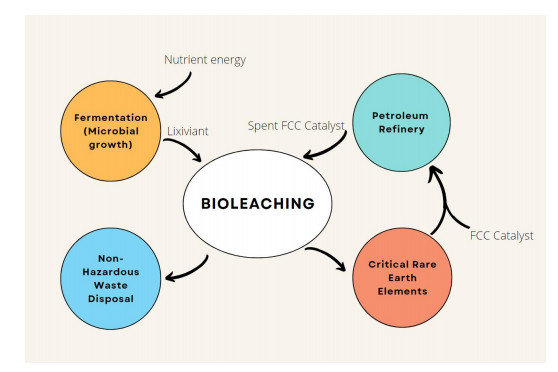









 DownLoad:
DownLoad:

